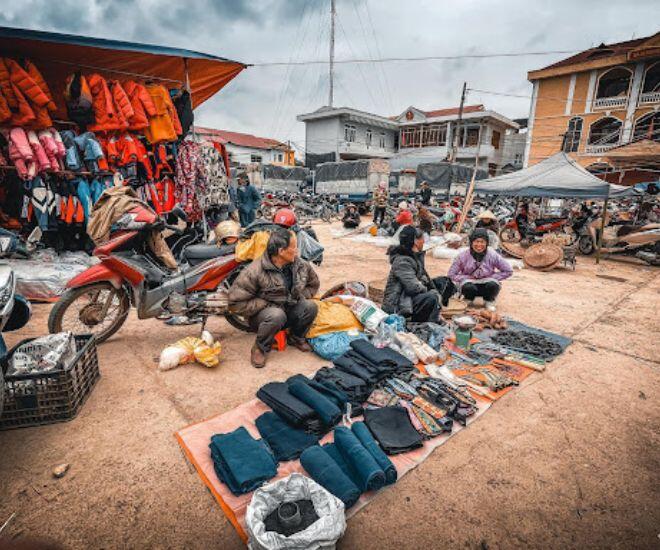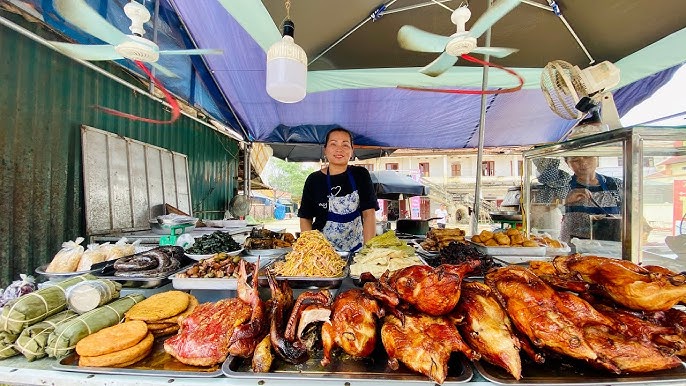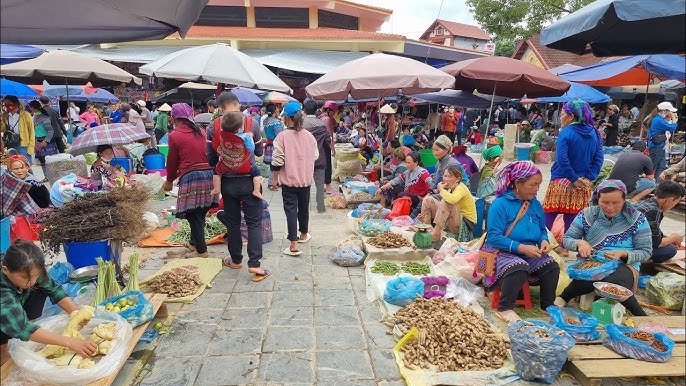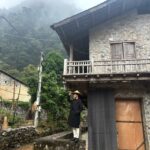A Century-Long Historical Journey
According to local records, Trùng Khánh Market emerged in the 19th century, originating from the trading needs of the residents of the villages around Bản Giốc waterfall and Quây Sơn river. Initially, the market was just a temporary gathering place by the river, gradually developing into a commercial center due to its advantageous location on the Vietnam-China trade route.

In the 1960s, the market was planned as a fixed area with rows of shops built from bee bricks and yin-yang tiled roofs. The recognition of Bản Giốc waterfall as a Special National Relic in 2018 boosted Trùng Khánh Market as a must-visit destination in the “Eastern Route” of the Geopark.
According to the latest report from the Cao Bằng Department of Culture (2024), the market currently operates five sessions per month on the 5th, 10th, 15th, 20th, and 25th of the lunar calendar, attracting about 300-500 customers each session. Despite the heavy impact of the COVID-19 pandemic, the market retained 80% of its traders compared to 2019.
Unique Architecture with Tày Cultural Soul
Trùng Khánh Market is designed in the style of the traditional stilt house of the Tày people with a sturdy system of lim wood columns and fish-scale tiled roofs. The market compound is scientifically divided into three main areas: agricultural products, handicrafts, and cuisine.

The agricultural area focuses on typical highland vegetables such as cabbage, chayote, pumpkin, and various precious medicinal herbs. The handicraft area displays brocade, knives, and traditional weaving tools. Meanwhile, the culinary area consists of small eateries serving local specialties, offering visitors a chance to experience the unique highland culinary culture.
A Paradise of Border Specialties
Visiting Trùng Khánh Market, tourists will be amazed at the diversity of local specialties. The most prominent is Trùng Khánh chestnuts, grown on limestone mountains, with a characteristic buttery taste and a price ranging from 50,000 to 80,000 VND/kg depending on the season.
Stone bamboo shoots, a specialty harvested from the primary forest, are processed into dried bamboo shoots priced at 120,000 VND/kg or fresh pickled bamboo shoots at 30,000 VND/bag. Shan Tuyet tea, a precious tea from 200-300-year-old ancient trees, is sold for 150,000 to 200,000 VND/kg.

The handicraft area is equally abundant with Dao Do brocade fabric, woven with sun and tree-of-life patterns, priced from 300,000 to 500,000 VND/piece. The Mong scimitar, a handmade product forged from scrap steel with a sharp blade, is sold for 200,000 to 350,000 VND/piece.
The cuisine at Trùng Khánh Market is a highlight not to be missed, featuring specialties such as “heo cap nach” (suckling pig grilled whole over charcoal, served with mac mat leaves) priced at 250,000 VND/kg; “xoi tram den” (glutinous rice mixed with finely chopped tram fruit, scented with firewood smoke) at 20,000 VND/serving; and Mong corn wine (aged in ceramic jars for 6 months, with a sweet aftertaste and spicy flavor) at 100,000 VND/500ml bottle.
Exploration Tips
For a complete experience at Trùng Khánh Market, visitors should arrive between 5:00 and 7:00 in the morning. This is the ideal time to select fresh produce and witness the ethnic minorities in their traditional attire bringing goods to the market.
When shopping, visitors can apply some negotiation tips such as buying in bulk (getting a 10-15% discount when purchasing 3kg or more) and preparing small denominations of cash as many traders do not have POS machines. Additionally, visitors should be mindful of local culture, such as avoiding wearing short skirts or sleeveless shirts, asking for permission before taking pictures of sellers, and learning a few Tày phrases like “TẦƯN MƯNG” (thank you) to create a good impression.
Challenges and Development Orientation
Despite its appeal, Trùng Khánh Market faces challenges in the digital age. Statistics show that 30% of young traders have switched to online sales, creating competition for the traditional market model. Moreover, the area of chestnut forests has decreased by 15% due to climate change (according to the People’s Committee of Trùng Khánh District, 2024), affecting the supply of specialty ingredients.

For sustainable development, Trùng Khánh Market is implementing solutions such as combining experiential tourism through organizing “A Day as a Farmer” tours for guests to participate in chestnut harvesting and brocade weaving. In parallel, the digitization of products through the construction of virtual stalls on e-commerce platforms is being promoted to introduce highland specialties to more consumers.
Trùng Khánh Market is not just a place for commodity exchange but also a bridge between the past and the present, between tradition and modernity. Preserving this unique culture requires the joint efforts of the community so that each market day remains a “vivid painting” of highland life, contributing to the richness of the cultural heritage of the UNESCO Global Geopark of Cao Bằng.































